
Hyssopus (hyssop) is a genus of herbaceous or semi-woody plants in the family Lamiaceae, native from the east Mediterranean to central Asia as far east as Mongolia. They are aromatic, with erect branched stems up to 60 cm long covered with fine hairs at the tips. The leaves are narrow oblong, 2–5 cm long. The small blue flowers are borne on the upper part of the branches during summer. By far the best-known species is the herb hyssop, widely cultivated outside its native area in the Mediterranean.
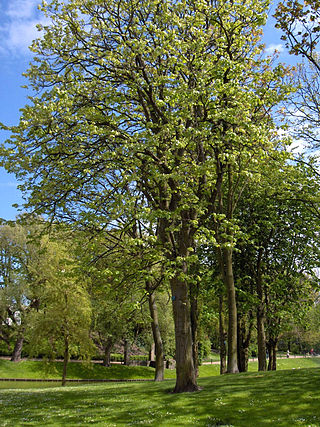
Tilia platyphyllos, the large-leaved lime or large-leaved linden, is a species of flowering plant in the family Malvaceae (Tiliaceae). It is a deciduous tree, native to much of continental Europe as well as southwestern Great Britain, growing on lime-rich soils. The common names largeleaf linden and large-leaved linden are in standard use throughout the English-speaking world except in the British Isles, where it is known as large-leaved lime. The name "lime", possibly a corruption of "line" originally from "lind", has been in use for centuries and also attaches to other species of Tilia. It is not, however, closely related to the lime fruit tree, a species of citrus.

Berberis, commonly known as barberry, is a large genus of deciduous and evergreen shrubs from 1–5 m (3.3–16.4 ft) tall, found throughout temperate and subtropical regions of the world. Species diversity is greatest in South America and Asia; Europe, Africa and North America have native species as well. The best-known Berberis species is the European barberry, Berberis vulgaris, which is common in Europe, North Africa, the Middle East, and central Asia, and has been widely introduced in North America. Many of the species have spines on the shoots and all along the margins of the leaves.

Agastache is a genus of aromatic flowering herbaceous perennial plants in the family Lamiaceae. It contains 22 species, mainly native to North America, one species native to eastern Asia. The common names of the species are a variety of fairly ambiguous and confusing "hyssops" and "mints"; as a whole the genus is known as giant hyssops or hummingbird mints.
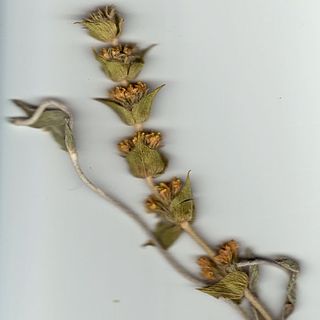
Sideritis, also known as ironwort, mountain tea, and shepherd's tea, is a genus of flowering plants known for their use as herbal medicine, commonly as a herbal tea. They are abundant in Mediterranean regions, the Balkans, the Iberian Peninsula and Macaronesia, but can also be found in Central Europe and temperate Asia.

Sonchus asper, the prickly sow-thistle, rough milk thistle, spiny sowthistle, sharp-fringed sow thistle, or spiny-leaved sow thistle, is a widespread flowering plant in the tribe Cichorieae within the family Asteraceae.

Cuphea hyssopifolia, the false heather, Mexican heather, Hawaiian heather or elfin herb, is a small evergreen shrub native to Mexico, Guatemala, and Honduras.

Hyssopus officinalis or hyssop is a shrub in the Lamiaceae or mint family native to Southern Europe, the Middle East, and the region surrounding the Caspian Sea. Due to its purported properties as an antiseptic, cough reliever, and expectorant, it has been used in traditional herbal medicine.

Lythrum hyssopifolia is a species of flowering plant in the loosestrife family known by the common names hyssop loosestrife and grass-poly. It is native to Europe but it is known elsewhere, including parts of Australia and eastern and western North America, as an introduced species and sometimes a weed. It is rare in the United Kingdom, with occasional isolated populations. It often grows in moist habitats, such as marshes and wet agricultural fields, rice paddies, for example.
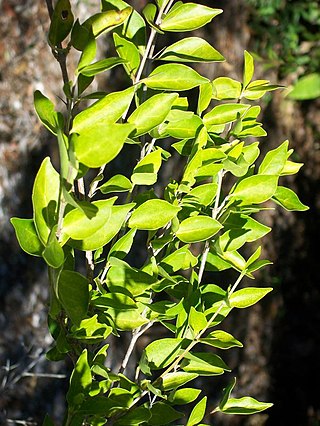
Randia moorei, commonly known as the spiny gardenia, is a rare Australian shrub growing in the far north eastern areas of the state of New South Wales and adjacent areas in Queensland. The habitat is subtropical rainforest north of Lismore.

Agastache pallidiflora, commonly known as New Mexico giant hyssop or Bill Williams Mountain giant hyssop, is a plant in the mint family.

Bassia hyssopifolia is a species of flowering plant in the family Amaranthaceae, known by the common names five-horn smotherweed, five-hook bassia, and thorn orache. It is native to parts of Asia and Eastern Europe, and it is known on other continents as an introduced species, including North and South America and Australia. It is a weed, invasive at times.

Sideritis cypria, the Cyprus ironwort, is a species of flowering plant in the family Lamiaceae. Erect perennial herb with a woody base, 60 cm high, with densely hairy tetragonal shoots. Leaves, opposite, simple, obscurely serrate, densely hairy, thick, oblanceolate, 3-12 x 1–5 cm. Flowers in verticillasters subtended by the cup-like bracts, zygomorphic, corolla bright yellow. Flowers from June to August. Fruit of 4 nutlets.

Agastache nepetoides, commonly known as yellow giant hyssop, is a perennial flowering plant native to the central and eastern United States and Canada. It is a member of the Lamiaceae (mint) family.

Satureja thymbra, commonly known as savory of Crete, whorled savory, pink savory, and Roman hyssop, is a perennial-green dwarf shrub of the family Lamiaceae, having strongly scented leaves, native to Libya, southeastern Europe from Sardinia to Turkey; Cyprus, Lebanon and Israel (Palestine). The plant is noted for its dark-green leaves which grow on numerous, closely compacted branches, reaching a height of 20–50 cm. The plant bears pink to purple flowers that blossom between March and June.
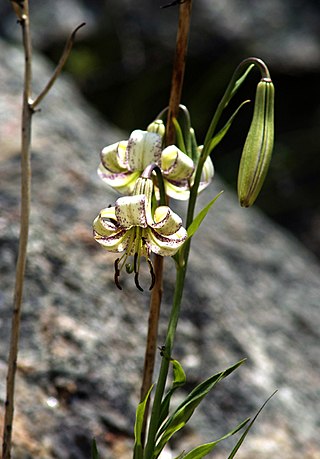
Lilium polyphyllum is a species of lily endemic to montane environments in central Asia.

Symphyotrichum firmum, commonly known as shining aster, shiny-leaved aster, smooth swamp aster, and glossy-leaved aster, is a species of flowering plant in the daisy family Asteraceae native to Canada and the United States.
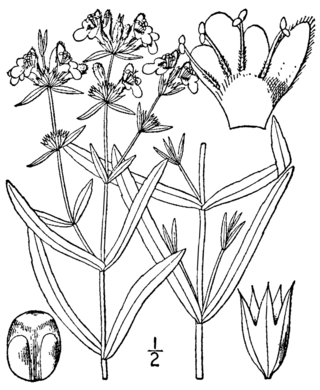
Stachys hyssopifolia, commonly known as hyssop-leaf hedge-nettle, rough hedge-nettlehyssop-leaved hedgenettle, and hyssop hedge-nettle is a species of flowering plant in the mint family (Lamiaceae).
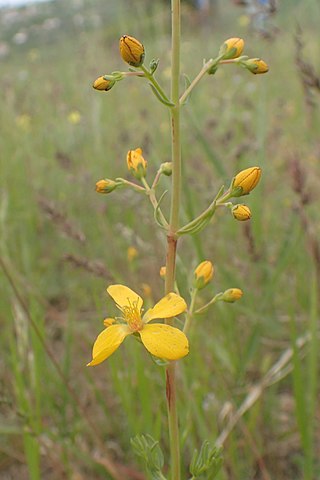
Hypericum hyssopifolium, the hyssop-leaved St. John's wort, is a species of flowering plant of the St. John's wort family (Hypericaceae) which is native to the Mediterranean and Black Sea regions. It grows on chalky or limestone soil in open woods or scrub at elevations of 500–1,800 m (1,600–5,900 ft) in Spain, France, Italy, Bulgaria, Crimea, and the Caucasus.























